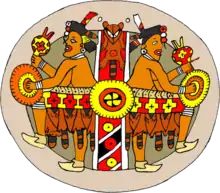Peñon woman
Peñon woman or Peñon Woman III is the name for the human remains, specifically a skull, of a Paleo-Indian woman found by an ancient lake bed in Pueblo Peñón de los Baños in Mexico City in 1959.[1]
Discovery
Peñon Woman III was found on an island in the middle of Lake Texcoco.[2]
The skeleton's age has been estimated by radiocarbon dating by Silvia Gonzalez of Liverpool John Moores University.[3] Her 14C date is 10,755±55 years[2] (12,705 cal years) BP.
She is one of the oldest human remains found in the Americas.[4][5][6]
Gonzalez theorizes that Peñon woman is related to the historic Pericú people of Baja California, who also shared similar physical traits.[7]
See also
- Archaeology of the Americas
- Arlington Springs Man – (Human remains)
- Buhl woman – (Human remains)
- Calico Early Man Site – (Archeological site)
- Cueva de las Manos – (Cave paintings)
- Fort Rock Cave – (Archeological site)
- Kennewick Man – (Human remains)
- List of unsolved deaths
- Luzia Woman – (Human remains)
- Kwäday Dän Ts'ìnchi – (Human remains)
- Marmes Rockshelter – (Archeological site)
- Paisley Caves – (Archeological site)
- Leanderthal Lady – (Human remains)
- Forensic anthropology
Notes
- Connor, Steve (3 December 2002). "Does skull prove that the first Americans came from Europe?". The Independent. London. Retrieved 23 June 2011.
- Grattan and Torrence 91
- "The New World may be far older than it originally seemed." The Economist. 14 July 2005. Retrieved 15 April 2012.
- Legon, Jeordan. "Scientist: Oldest American skull found." CNN 4 Dec 2002. Retrieved 15 April 2012.
- Steve Connor (3 December 2002). "Does skull prove that the first Americans came from Europe?". The Independent.
- "George Erikson: Who Were The Earliest Americans?". historynewsnetwork.org.
- Rincon, Paul. "Tribe challenges American origins." BBC News. 7 Sept 2004. Retrieved 15 April 2012.
References
- Grattan, John and Robin Torrence, eds. Living Under the Shadow: Cultural Impacts of Volcanic Eruptions. Walnut Creek, CA: Left Coast Press, 2007. ISBN 978-1-59874-268-8.
This article is issued from Wikipedia. The text is licensed under Creative Commons - Attribution - Sharealike. Additional terms may apply for the media files.
